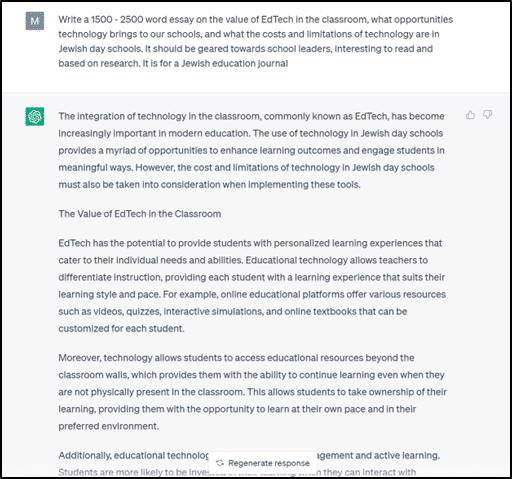
Reflections of a Digital Immigrant
June 28, 2023
Automate and Educate: Streamlining School Processes with Automation
June 28, 2023Mushkie Lipsker

I asked ChatGPT: “Write a 1500–2500 word essay on the value of EdTech in the classroom, what opportunities technology brings to our schools, and what the costs and limitations of technology are in Jewish day schools. It should be geared towards school leaders, interesting to read, and based on research. It is for a Jewish education journal.”
I waited two minutes, and there it was! Don’t believe me? Check out the image below.

With technology on the rise and artificial intelligence being available like never before, teachers who may have not integrated much tech into the classroom are forced to wonder: Can technology help me as a teacher? Can technology bring my classroom to a better place? Can technology increase class engagement, collaboration, and creativity? (Spoiler alert: the answer to all those questions is yes!)
Together with amazement and wonder comes some worry: Where is the future going? Will it be all digital? Will AI replace me, their teacher?
Almost 30 years ago, in 1995, Newsweek predicted “Why the Internet Won’t Be Nirvana” and said that the Internet wasn’t easy enough to navigate and was destined to fail, nothing more than a passing craze. Similar predictions were made about the iPhone and online shopping. How wrong they all were. From shopping to banking, traveling to healthcare, this world has evolved so much with the growth of the internet. Siri replaced dictionaries; we have Google Maps and Waze instead of paper maps. Schools don’t teach typing anymore, yet today, even newborns are taking their parents’ phones and typing random letters and emojis on WhatsApp groups. Thirty years ago, writing an essay meant researching physical books; today, ChatGPT can write it for you in a matter of thirty seconds or so.
In 1992, there were a total of ten websites. Now? 547,200 new websites are created each DAY. That is six websites per SECOND! (Yes, you read that right!)
As mind-blowing as the changes of the last three decades have been, the change still to come in the next three decades isn’t even something we can truly fathom. The job predictions for 2053, when our current students will be adults, are drone traffic optimizers, outer space tour guides (how much do you think those tours will cost?!), digital removal specialists, and AI ethicists. How do we teach for the future when we can’t even imagine what that future world will look like?
Well, let’s look at which skills will NEVER expire:
- critical thinking
- communication
- collaboration
- creativity
Canva, MidJourney AI, or even ChatGPT will never replace these 4 C’s of 21st century learning. No matter how advanced technology gets, these four skills will always be critical to success. Technology may be an extremely helpful tool, but some things can never be replaced. No, educators, your job is not replaceable by a computer. Because you give over so much more than just information. You give over your perspective, warm touch, and passion for your curriculum. Just as the power drill didn’t make construction workers obsolete, AI and other technology won’t replace teachers. Educators are the force behind the tool.
Not only is technology not a contradiction to the 4 C’s, but it can be a great tool to teach the 4 C’s more effectively. Using technology is not only helpful for your students in the classroom, but it can also help YOU save time, plan lessons more quickly, or grade quizzes automatically, giving you energy and time to focus on what matters most – your relationship with your students.
The 4 C’s
Here are several ways I brought the 4 C’s into my classroom, with some website recommendations so you can use them:
Critical thinking - As a teacher, you can use ChatGPT to generate open-ended higher-order thinking questions and prompts related to a specific topic or subject. These questions can be used to stimulate discussion and encourage students to think deeply about the topic (chat.openai.com).
- Students can take part in polls and then defend their opinions (polleverywhere.com or Kahoot’s polling options).
- Students should be able to use critical thinking to safely navigate the internet, see if sources are credible, etc.
- The internet gives such vast amounts of information. Through using the large research pool, students can compare and contrast texts and sources and make informed decisions.
Communication - As a teacher, you can ask ChatGPT to generate writing prompts or conversation starters that require students to express their ideas clearly and concisely (chat.openai.com).
- Students can conference with students from another school to work on a project together and/or learn from one another such as learning about their culture or practicing a new language. (They can use Zoom, Google Meet, etc. for this.)
- Students should learn how to be good digital citizens, especially with a more digital future.
Collaboration - Teachers can ask ChatGPT for tutorials or tips on how to set up a virtual classroom, how to add students to the platform, and how to assign and grade assignments so students can work collaboratively on an online platform, such as Edmodo or Google Classroom (chat.openai.com).
- Students can collaborate via docs and other collaborative apps (all google drive apps, for example).
- Students can discuss a topic/question on discussion forums and then respond to each other’s thoughts (the navi platform through CoJDS was great for this).
- My students even collaborated with students from another school to design a mini website using wix.com.
- Students can design a website to which they add throughout the year as they learn more on the topic. (We made a Shoftim website on wix.com to which we then added sections throughout the year as we learned about each shofet.)
- Students work together to create a game as a review for a unit assessment (using kahoot.com).
Creativity - ChatGPT can inspire creativity by generating prompts for creative writing, art, or design projects. Teachers can ask ChatGPT to provide students with prompts that challenge them to think outside the box and come up with innovative solutions to problems (chat.openai.com).
- Students can create 3D models of the keilim used in the mishkan and print them on a 3F printer. (We collaborated with the engineering teacher and the students worked in Tinkercad.)
- Students can create comic strips based on a story in Tanach (storyboardthat.com).
- Students can create business cards for famous personalities they are learning about (vistaprint.com or canva.com).
- Students can write and design guidebooks, answering the essential questions of the unit (canva.com).
- Students can design videos to teach an idea or theme to their classmates (animoto.com).
- Students can create mock text message conversations that “could have” happened based on the text they are learning (ifaketextmessage.com).
The SAMR Model
As great as bringing technology into the classroom can be, it’s important to be mindful of the purpose of the tech. Bringing Chromebooks to your classroom just for the sake of ticking off the “I bring technology into my classroom” check box isn’t enough. There should be a goal in mind that technology can help you accomplish.
The SAMR model is a framework for integrating technology into teaching and learning, developed by Dr. Ruben Puentedura. The model is based on four levels of technology integration: substitution, augmentation, modification, and redefinition.
- Substitution: This level involves using technology to replace traditional tools and methods without changing the fundamental nature of the task. For example, using Google Docs to write a paper instead of handwriting it.
- Augmentation: At this level, technology is used to enhance or improve the task, but the main task remains the same. For example, using a spell-check tool or grammar-check tool to improve the quality of a written document, or using a virtual whiteboard to draw and present ideas in real-time.
- Modification: This level involves using technology to modify the task in a significant way. For example, using a digital portfolio to showcase student work can allow them to present it more dynamically and interactively, which wouldn’t be possible on a printed portfolio. It can include voice recording, video, and opportunities for the viewer to interact (vote, comment, etc.) with the material.
- Redefinition: At the highest level of the SAMR model, technology is used to create entirely new learning experiences that were not previously possible. Learning is completely transformed, enabling new types of learning, collaboration, and creativity. For example, students may use virtual reality to explore places they are learning about in history or create a narrated Google Earth tour for a social studies unit. This can also include polling and getting opinions from around the world in a volume that simply isn’t possible without the new tech.
In the early 1950’s, a girl and her parents once went to meet the Lubavitcher Rebbe. The little girl looked very worried and so the Lubavitcher Rebbe asked her what was wrong. She said she was nervous about nuclear energy and she asked, “Is nuclear energy good or bad?” The Lubavitcher Rebbe answered, “Do you have a knife in your kitchen? Are knives good or bad?” “It depends on how you use it,” she said. “Exactly,” the Rebbe told her, “It depends on how you use it.” Just as with many things in life, technology is neither good nor bad, but it is what you make of it. Using the SAMR model, teachers can ensure that technology is integrated effectively into the classroom, supporting student learning and engagement, and serving its purpose.
It’s important to take proper precautions when bringing technology into the classroom. It’s important to put safeguards into place and teach students about digital citizenship and the dangers of the internet. But technology can and should be embraced. Don’t be like the old newspapers and deny the future – embrace it and let it help both you and your students.
And to answer the question in the title, no, ChatGPT didn’t write this. While ChatGPT could come up with a theoretical essay, ChatGPT couldn’t write about my experiences, my point of view, or my perspective. Only I could. And in an era of artificial intelligence, that human touch of the teacher can never be replaced.
Mushkie Lipsker, M.Ed., is the founder of Ever-Growing Educator, a resource for teachers to develop and sharpen a growth mindset. For practical education tips that are so easy to implement, you can start using them the same day (!) follow @EverGrowingEducator on Instagram. You can sign up for weekly emails at EverGrowingEducator.com or contact her at [email protected]

